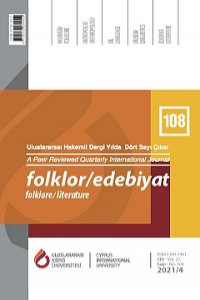Haiku Estetiği ve Oruç Aruoba’nın Haikuları Üzerine Yapısal Bir Deneme
A Structural Essay on Haiku Aesthetics and Oruç Aruoba’s Haikus
Author(s): Nurcihan Akhan, Didem Ardalı BüyükarmanSubject(s): Poetry, French Literature, Turkish Literature, East Asian Philosophy, Transformation Period (1990 - 2010), Translation Studies
Published by: Uluslararası Kıbrıs Üniversitesi
Keywords: Oruç Aruoba; haiku; Ne Kİ Hiç; poetry; nature; Turkish literature;
Summary/Abstract: Haiku is the shortest type of poetry known in the World. After leaving the borders of Japan, the first reflections appear especially in French poetry. Haiku, which has Japanese culture and beliefs in its background, is not a creed but has a life philosophy with its own. Haiku tries to put forward that philosophy of life in the simplest way. In Japanese culture and beliefs, nature takes the first place. Haiku carries the traces of a life identical to nature. Haiku poetry, which entered Turkish literature with French translations, is not a type of poetry adopted until recently, although its name is mentioned from time to time. But in 90’s, haiku has become popular in Turkish poetry. Also in that years, respectable amount of haiku readers begin to emerge in our country. In this article, the brief history of haiku as a genre is mentioned and main points in Turkish poetry were tried to be determined. Finally, the haikus written by Oruç Aruoba, who have made significant contributions to the recognition and meaning of haiku poetry, have been evaluated. Some of the haikus he wrote were selected and examined in terms of structure and essence, and it was tried to draw attention to the polysemy of haiku.
Journal: Folklor/Edebiyat
- Issue Year: 27/2021
- Issue No: 108
- Page Range: 1127-1138
- Page Count: 12
- Language: Turkish

